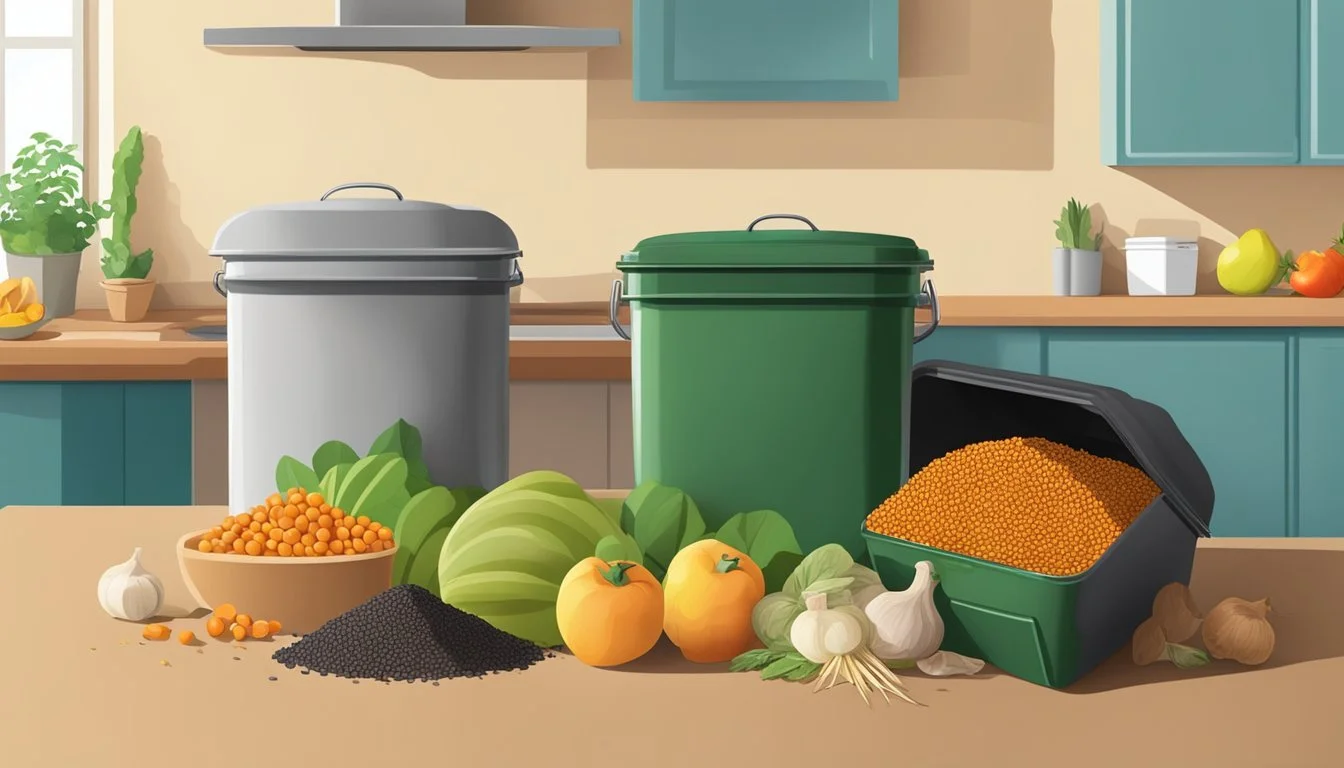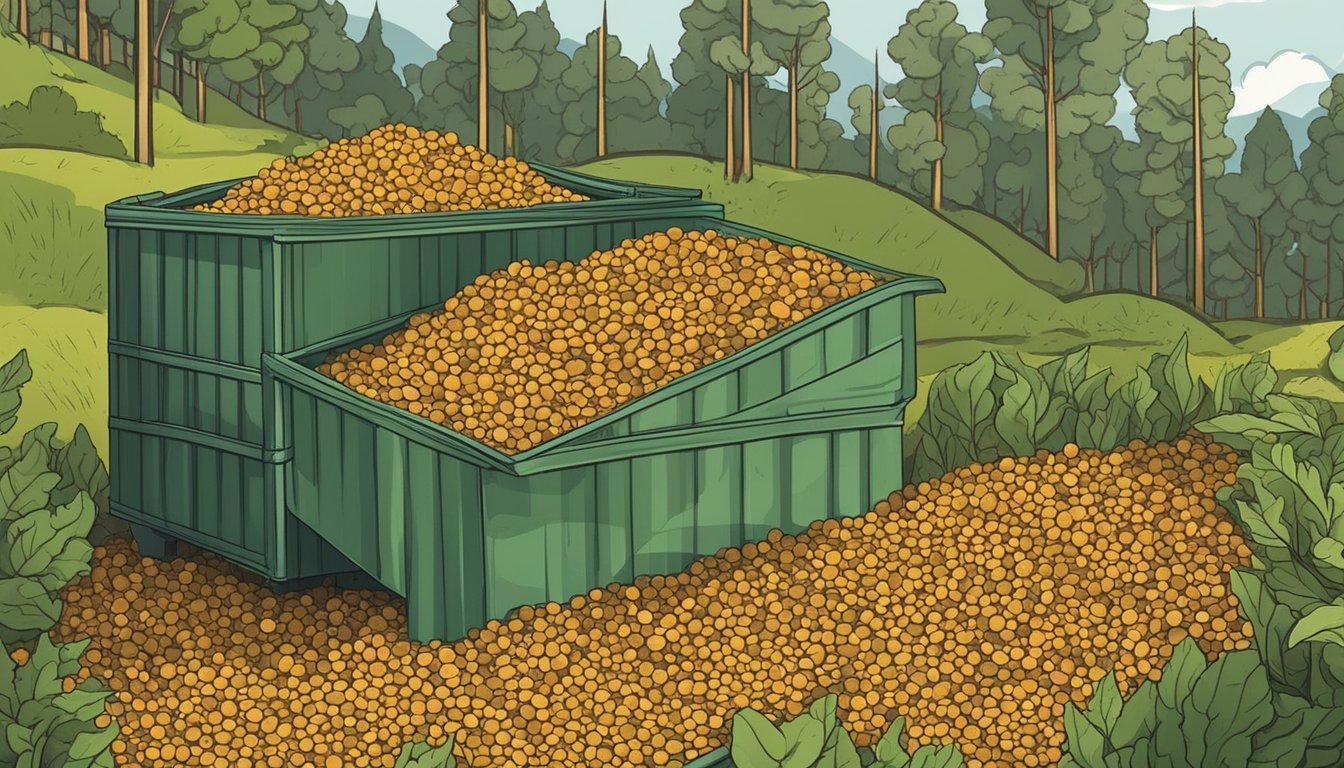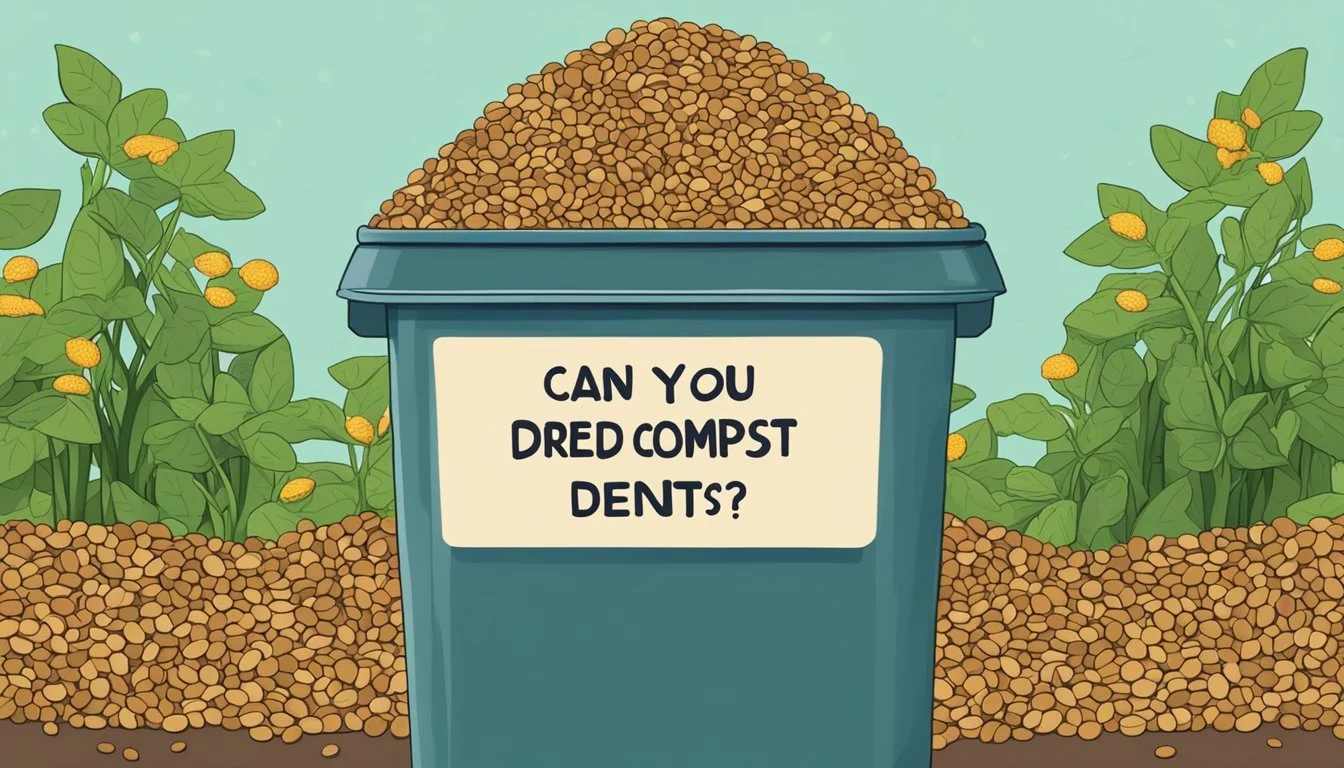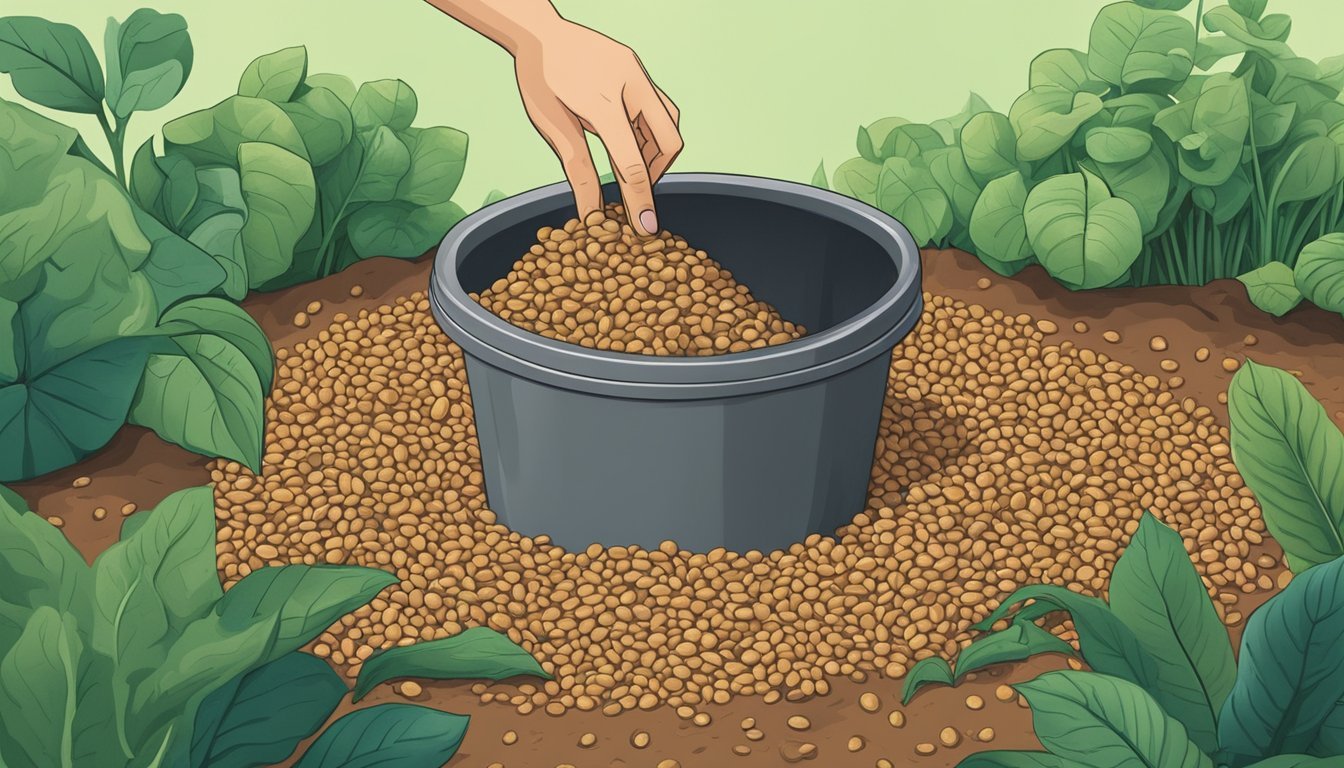Can You Compost Dried Lentils?
Unveiling the Truth About Legume Composting
Composting is a natural process that turns organic waste into nutrient-rich soil amendments, beneficial for gardening and farming. Many household items can be added to compost piles, including a variety of food scraps and yard waste. One common question among composting enthusiasts and gardeners is whether dried lentils can be added to compost bins.
Dried lentils can indeed be composted. They are an excellent source of nitrogen, an essential element that contributes to the composting process by fostering microbial activity. As a plant-based kitchen scrap, dried lentils decompose relatively quickly compared to other organic materials. They are categorized as green compost material, although physically they may not be green in color. This green categorization aligns with their properties as a nitrogen-rich substance, not their actual hue.
It is important, however, to maintain a proper balance between green materials like dried lentils and brown materials, such as fallen leaves and shredded paper, in a compost pile. The ideal green to brown ratio ensures that the compost is well-aerated, moist, and conducive for the microorganisms to break down the waste effectively. Overloading the compost with lentils or any high-nitrogen content material could disrupt this balance, potentially leading to a slower decomposition process or foul odors. Therefore, moderation is key when adding dried lentils to compost.
Basics of Composting
Composting is the process that allows organic matter to decompose naturally, resulting in a product that can enrich soil with essential nutrients. This section explores both what compost is and its numerous advantages.
What Is Compost?
Compost is the end product after organic materials, such as food scraps, leaves, and grass clippings, have broken down over time. Microorganisms, bacteria, and other decomposers play a pivotal role in this process. They transform the waste into a nutrient-rich material ideal for enhancing soil quality. Proper airflow and moisture are essential in this process, as they speed up the decomposition while preventing foul odors and deterring pests.
Benefits of Composting
Composting offers multiple benefits for both the environment and the gardener:
Soil Improvement: Compost improves soil structure, enabling it to better retain nutrients, water, and air.
Waste Reduction: It reduces the volume of waste sent to landfills by repurposing organic waste into beneficial compost.
Plant Health: Plants thrive with the addition of compost because it provides them with necessary nutrients and helps combat soil-borne diseases.
By integrating compost into gardening practices, one not only recycles organic waste but also creates a sustainability cycle that enhances overall plant and soil health.
Composting Materials
Composting is an effective method to recycle organic waste into a rich soil amendment. It relies on the right balance of green and brown materials, and avoiding certain items that can disrupt the composting process.
Green and Brown Materials
Green materials are rich in nitrogen, essential for composting. They decompose quickly and include kitchen scraps like fruit and veggie trimmings, coffee grounds, fresh leaves, and grass clippings. Dried lentils and other beans can also be considered green materials as they contain nitrogen and, once dried, can be added to the compost.
Green Materials Nitrogen Content Examples High Lentils Coffee grounds, veggie scraps Medium to High Grass Clippings Fruit waste, leaves
Brown materials, on the other hand, are rich in carbon. Browns are typically dry and include items such as stems, newspaper, and sawdust. These materials add structure to the compost and help to balance moisture.
Brown Materials Carbon Content Examples High Newspaper Dry leaves, branches Medium Stems Cardboard, sawdust
A general guideline is to maintain a ratio of 1 part green to 2 parts brown materials to ensure a proper balance for effective composting.
Items to Avoid in Compost
Not everything is suitable for composting. Certain items might attract pests, introduce diseases, create odors, or disrupt the balance of the pile.
Meat, dairy, and oils should never be composted as they can attract pests and cause odors.
Bread and products containing oil, like salad dressings, may also attract unwanted pests and should be avoided.
Diseased plants might spread pathogens in the compost which can then be transferred to your garden.
Materials like painted wood or treated wood contain harmful chemicals that could leach into the compost and are not safe to decompose in a compost pile.
A well-maintained compost bin that adheres to these guidelines will produce nutrient-rich compost beneficial for garden and plant growth.
Setting Up Your Compost Bin
The successful creation of compost hinges upon the selection of an appropriate bin and its correct placement. These choices affect composting efficiency by influencing moisture, temperature, and aeration.
Choosing the Right Bin
When selecting a compost bin, one must consider size, materials, and functionality. The right bin accommodates the volume of waste produced and fits well within the available space in one's garden or yard. Bins come in various materials, but durable, weather-resistant options like plastic or metal are common. Some may prefer wood for its natural aesthetics, but one should ensure it is untreated to avoid chemicals leaching into the compost.
Size: A container that is too small will quickly overflow, while an overly large one may impede the composting process due to insufficient heat buildup.
Materials: Choose between plastic, metal, or wood, taking into account durability and maintenance.
Functionality: Consider bins with features that aid in composting, such as built-in aeration, tumbling mechanisms, or dual chambers for ongoing composting cycles.
Composting containers should promote good airflow and proper drainage to prevent the compost pile from soaking and becoming anaerobic, which can lead to unpleasant odors and slowed decomposition. A balanced compost requires a mix of green and brown materials, where green adds nitrogen (like vegetable scraps or grass clippings) and brown provides carbon (like dry leaves or branches).
Location and Placement
The placement of the compost bin is crucial for effective decomposition. A location with partial sunlight aids in maintaining the optimal temperature, while too much sun exposure may dry out the bin and too much shade might keep it excessively damp.
Sunlight: Partial sunlight helps to warm the compost, speeding up the composting process without drying it out.
Accessibility: The bin should be conveniently located near the kitchen or garden for easy deposit of food scraps and yard waste.
Drainage and Airflow: A spot on level ground with good drainage ensures excess moisture can escape, preventing the materials from becoming waterlogged. Sufficient space around the bin allows for airflow, which is necessary for aerobic composting.
Garden Proximity: Proximity to the garden is beneficial, making it easier to transfer the finished compost.
The compost bin should allow for easy addition of materials and mixing or turning to enhance decomposition. Compost piles require regular maintenance, such as turning to incorporate oxygen and checking moisture levels—compost should feel like a wrung-out sponge. Remember, the right setting for a compost bin fosters a balance of moisture, heat, and airflow, ensuring a productive composting process.
Composting Process
The composting process for materials like dried lentils involves careful balancing of organic components and management of the decomposition stages. An understanding of the phases and maintenance techniques ensures a successful transformation into nutrient-rich compost.
Stages of Composting
1. Initial Stage:
Microorganism activity: Begins when green and brown materials are mixed, introducing bacteria which facilitate the breakdown.
Temperature rise: Indicates the activity of microorganisms as they turn the pile, resulting in a temperature increase, a stage often termed 'hot compost'.
2. Active Stage:
Rapid decomposition: Takes place as bacteria, fungi, and other microorganisms proliferate, generating heat.
Oxygen infusion: Regular turning of the compost pile is crucial to provide oxygen, which supports aerobic bacteria and speeds up growth and decomposition.
3. Cooling and Maturation:
Change in bacterial population: As the pile cools, different microorganisms take over to further break down the compost.
Humus formation: The final product, humus, is stable and rich in nutrients, indicating that the compost is ready for use.
Maintaining the Compost Pile
Balancing Materials: A proper ratio of green (nitrogen-rich) and brown (carbon-rich) materials is essential in creating an ideal environment for composting.
Green Materials Brown Materials Dried lentils Dead leaves Vegetable scraps Straw or hay Fruit wastes Sawdust Coffee grounds Cardboard pieces
Aeration: Regular turning of the pile introduces oxygen, promoting aerobic bacteria activity and preventing unpleasant odors.
Moisture Control: The compost pile should be moist, like a wrung-out sponge, to maintain microbial activity without creating anaerobic conditions.
Monitoring Temperature: A hot compost pile (130-150°F) accelerates composting and kills pathogens and weed seeds. The pile should be turned when the temperature peaks then starts to cool.
Using Lentils in Compost
Adding lentils to compost provides a rich source of nitrogen, a key nutrient for effective composting. Lentils also support the development of beneficial microorganisms that are crucial in transforming organic waste into healthy, nutrient-packed soil.
Benefits of Adding Lentils
Lentils are an excellent addition to a compost pile due to their high nitrogen content, which is essential for compost health. They act as a green compost material, which means they provide energy for the microbes that break down the waste. This process is vital to creating a balanced compost. Composting lentils also contributes to the overall fertilizer quality of the finished product by adding nutrients such as potassium.
The benefits of adding lentils to compost include:
Enhancing microbial activity for faster decomposition
Contributing to a nutrient-rich fertilizer ideal for garden soil
Providing a balanced green addition to compost, alongside brown materials like leaves and twigs
How to Compost Lentils Properly
To compost lentils properly, they should be added to the compost pile along with a mixture of green materials, like vegetable scraps, and brown materials, such as dried leaves or straw. This helps maintain the right carbon to nitrogen ratio (C ratio). It's important to keep the lentils damp but not soaked, as excessive moisture can lead to odor problems and slower decomposition.
Here are specific steps for composting lentils effectively:
Scatter dried lentils evenly within the compost pile to avoid clumping.
Cover lentils with brown compost material to prevent pests and improve aeration.
Turn the compost heap regularly to ensure that the lentils are adequately aerated and to speed up the composting process.
By incorporating lentils into compost, they decompose and their husk breaks down, thereby enhancing the structure and health of the resulting compost, which can be used to enrich garden soil.
Gardening with Compost
Composting is an essential practice that turns organic waste into a nutrient-rich amendment for the garden soil, bolstering plant growth and health. By integrating compost into the gardening routine, one can vastly improve soil structure and fertility.
Enriching the Soil
The incorporation of compost into garden soil significantly enhances its quality. Compost acts as a natural fertilizer, supplying organic matter and a diverse array of essential nutrients. When it comes to sowing seeds such as lentils, fertile compost can mean the difference between mediocre and bountiful harvests. By following these steps, one can enrich their soil effectively:
Test the soil to determine existing nutrient levels.
Spread a 2-4 inch layer of compost over the garden bed.
Till or dig the compost into the top 6 inches of soil.
Planting with Compost
During the planting phase, compost serves as an invaluable resource for young seedlings and direct-sown seeds. To optimize plant growth, gardeners can:
Mix compost into the holes or trenches made for planting.
Add a handful of compost around the base of each plant.
By doing so, the garden is better equipped to support robust growth and a vigorous garden ecosystem. Whether one is planting lentil seeds or other crops, using compost at the planting stage can accelerate root establishment and overall plant health.
Troubleshooting Compost Issues
Maintaining proper moisture levels and preventing pests are crucial to a successful composting process. This section will explore how to identify common compost problems and methods to deter pests effectively.
Common Compost Problems
Moisture and oxygen are two critical factors that can lead to a range of issues in a compost pile if not properly managed. Here's a quick reference to identify and solve some frequent problems:
Excess Moisture: Leads to soggy, smelly compost and anaerobic conditions. To combat this, aerate the pile and add dry materials, such as newspaper or sawdust, to absorb extra moisture.
Dry Compost: Slows down decomposition. To fix a parched pile, add water to re-wet the compost and include more green materials that contain moisture.
Pathogens and Diseases: Are less likely in a well-maintained pile. Ensure a proper balance of greens and browns to maintain the right temperature and discourage harmful microorganisms.
Fungus: Is a sign of overabundance of certain materials or insufficient turning. Regularly turn the compost to prevent fungal growth.
Preventing and Addressing Pests
Pests can turn composting into a challenging task. Here are strategies to prevent infestation and address pests if they appear:
Rodents: Use a rodent-proof bin with a lid and mesh wire to cover any openings, ensuring they are smaller than 1/4-inch.
Flies and Fruit Flies: Are attracted to exposed food scraps. Bury food waste deeply in the compost pile and cover new additions with dry, brown material.
Aphids and Ascochyta Blight: These pests can be prevented by not adding diseased plants to the pile and promoting good airflow to discourage aphids.
By following these strategies, one can ensure their compost remains healthy and efficient, reducing waste and returning valuable nutrients to the soil.
Sustainability and Composting
Composting is an integral part of a sustainable lifestyle, transforming organic matter into valuable fertilizer. This practice plays a critical role in reducing waste and supporting the environment.
Reducing Waste
Every year, a significant amount of organic waste ends up in landfills, contributing to the production of methane, a potent greenhouse gas. Composting provides an alternative by turning waste, such as dried lentils, into nutrient-rich soil. This process not only minimizes the volume of waste in landfills but also closes the circle of life for organic matter, allowing it to continue providing value.
Types of compostable organic matter:
Vegetable scraps
Fruit peels
Coffee grounds
Eggshells
Dried lentils and beans
Composting and the Environment
Composting benefits the environment beyond waste reduction. It encourages the production of beneficial bacteria and fungi, which break down organic matter to create humus—a rich nutrient-filled material. This enhances soil structure, reduces the need for chemical fertilizers, and helps combat soil erosion. Moreover, by enriching the soil, composting contributes to better water retention and supports healthier plant growth, leading to a more robust and sustainable ecosystem.
Environmental benefits of composting include:
Decreased reliance on chemical fertilizers
Enhanced water retention in soil
Reduction in greenhouse gas emissions from landfills
By integrating composting into everyday practices, households and communities contribute to a sustainable future for the planet.
Types of Lentils and Composting
When considering composting lentils, it's important to understand the varieties available and how they may vary in their composting process. This section explores the types of lentils most commonly grown and their respective suitability for inclusion in your compost heap.
Varieties of Lentils
Lentils grow in pods, requiring full sun to thrive, and are known as an annual crop that should be planted after the last frost date. They are a hardy plant that is susceptible to certain diseases, such as anthracnose, which growers must be vigilant against. Below is a table of common lentil varieties:
Variety Color Growing Notes Puy lentils Blue-green Originally from France, known for firm texture Green lentils Green Common variety, hold their shape well Red lentils Orange-red Typically split, cook quickly Brown lentils Brown Widely available, considered a standard lentil Black lentils Black Also known as Beluga lentils, rich flavor, retain shape well
Each type of lentil may require different fertilizing strategies, but growers generally find that lentils do not require high levels of fertility and can grow in poor soil conditions.
Composting Different Lentil Types
Lentils, regardless of the variety, make a good addition to a compost pile because they provide a nitrogen source that is essential for the composting process. Here's how to manage different types of lentil waste for composting:
Cooked Lentils: Should be added in moderate amounts to avoid attracting pests.
Raw Lentils: Can be composted directly, providing a rich source of nitrogen.
Lentil Plants: After harvest, the remaining plant material can be composted if free from disease.
When composting lentils, one should ensure a proper balance between green materials (nitrogen-rich) and brown materials (carbon-rich) to facilitate the best decomposition environment. Lentils, particularly those not treated with chemicals, are green materials in composting terminology. Diseased lentil plants should not be composted to avoid spreading pathogens. It's often recommended to bury food scraps such as lentils to speed up the composting process and prevent attracting animals.
Compost Harvesting and Usage
Harvesting compost efficiently and utilizing it to enhance garden soil plays a vital role in cultivating healthy plants and contributes to the sustainable practice of using organic waste as a resource.
How to Harvest Compost
Harvesting compost typically occurs when the material at the bottom of the pile is dark, crumbly, and has an earthy odor. At this stage, it should be sifted to separate any uncomposted material from the finished product.
Allow the compost pile to sit without adding new material, giving it time to fully decompose.
After a few months, check the bottom layer for finished compost.
Use a screen or compost sifter to separate out the compost from larger particles still breaking down.
Return any larger, unfinished compost pieces to the pile to continue decomposing.
Using Compost in Your Garden
When the compost is ready, using it in your garden can provide numerous benefits to your plants, including those grown from legumes like lentils.
Before planting, integrate the compost into the soil, adding rich organic matter that improves soil structure and fertility.
Apply a 2-3 inch layer of compost over garden beds and gently mix it into the top 6 inches of soil.
For lentil plants, which require good drainage and full sunlight, ensure the soil is loose and well-aerated by incorporating compost.
Compost can be used when planting to give a nutrient boost and when plants are growing to maintain soil health.
Nutrient-rich compost can support the cultivation of a variety of garden produce, from leafy greens for salads to legumes like lentils that can be harvested and used in dishes like lentil soup.
By following this guidance, gardeners ensure that they are not only recycling organic waste but also promoting optimal plant growth and soil health within their gardens.











